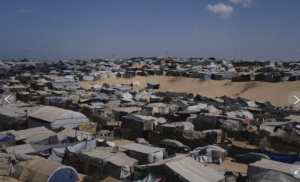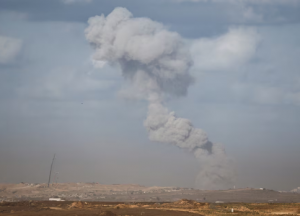
Published September 21, 2025
As Gaza reels from another round of deadly Israeli airstrikes that killed more than 40 people, the finger of responsibility points not only at the bombs but at Hamas itself. Behind the mounting civilian toll lies a cold, calculated strategy: Hamas has turned Gaza’s neighborhoods into its battlefield.
Hamas Hides in Plain Sight
Hamas’ strength does not lie in open battlefields but in the shadows of civilian life. Its fighters and commanders deliberately operate from the heart of Gaza’s neighborhoods, hiding in apartment complexes, mosques, schools, and even hospitals. Reports from past conflicts and intelligence findings have repeatedly revealed weapons caches under residential homes and tunnels running beneath marketplaces and clinics.
Rocket launchers are positioned near playgrounds, turning ordinary streets into launch pads of war. Command centers are hidden in office buildings. Underground bunkers stretch for miles beneath crowded refugee camps, ensuring that civilians aboveground are the first to absorb the consequences of Israeli strikes.
This strategy is not accidental—it is central to Hamas’ survival. By embedding itself among civilians, Hamas makes it nearly impossible for Israel to target its fighters without collateral damage. Every strike that kills civilians is then paraded as proof of Israeli aggression. The deaths become headlines, and the images become propaganda tools.
Analysts call this a “double shield” strategy: Gaza’s population provides physical protection for Hamas’ military assets, and their deaths provide political protection on the global stage. In other words, Hamas’ battlefield advantage does not come from superior firepower but from its willingness to sacrifice its own people.
Ordinary Gazans know this. Families whisper about the tunnels dug beneath their streets, the strange comings and goings in residential buildings, and the militants who disappear into basements before airstrikes come crashing down. Yet speaking out is impossible—Hamas rules Gaza with an iron grip, silencing dissent and leaving civilians trapped in a war they did not choose.
The Human Cost of “Human Shields”
Behind every collapsed building and every grieving family lies the cruel reality of Hamas’ war strategy: civilians are not merely caught in the crossfire—they are placed in it. Hamas uses Gaza’s men, women, and children as “human shields,” embedding its fighters and weapons among them, ensuring that any strike against its forces also strikes the innocent.
For families in Gaza, this means living in constant terror. Parents put their children to bed each night knowing a rocket launcher may be hidden nearby, or that tunnels beneath their homes make them targets from above. Even hospitals and schools, meant to be sanctuaries, are transformed into military assets. When the bombs fall, civilians are the first to suffer—not by chance, but by Hamas’ design.
Human rights organizations and military analysts alike have documented this tactic: fighters launching rockets from rooftops of family homes, weapons stockpiled in apartment basements, and command posts hidden in residential neighborhoods. Civilians are ordered—or coerced—not to leave, even when warnings of imminent strikes are given. In some cases, Hamas actively prevents evacuation, ensuring that casualties will mount.
The result is a landscape of tragedy. Mothers clutching lifeless children, fathers digging through rubble, communities wiped out in an instant. Each heartbreaking scene becomes part of Hamas’ propaganda war, broadcast to the world to demonize Israel while deflecting blame from the true architects of the carnage.
This is the terrible irony: the very people Hamas claims to represent are the ones it sacrifices most readily. Gaza’s civilians are not protected by Hamas; they are exploited by it—reduced to pawns in a brutal game of survival and political gain.
Israel’s Predicament
For Israel, the battlefield is a trap carefully laid by Hamas. Every rocket fired from Gaza must be answered, yet every strike risks international outrage. This is the no-win scenario Hamas has engineered: if Israel refrains from striking, its citizens remain vulnerable to relentless rocket fire; if it does strike, Hamas ensures that civilians will die, and Israel will take the blame.
The IDF (Israel Defense Forces) has developed systems to minimize civilian casualties—such as “roof knocking” warnings, leaflets urging evacuation, and targeted precision strikes. Yet these measures are undermined by Hamas’ deliberate choice to entrench itself in civilian neighborhoods. Militants launch rockets from rooftops where families still live, or from alleys where children play. In some cases, civilians are actively prevented from fleeing, trapped by Hamas to guarantee civilian deaths when the counterstrike comes.
This leaves Israel with a grim dilemma: allow Hamas to operate freely and risk more Israeli lives, or act decisively and face international condemnation. Hamas counts on this dynamic. Each Israeli strike that kills civilians becomes fuel for its propaganda, casting Israel as the aggressor while hiding Hamas’ role in engineering the tragedy.
Israeli officials argue that the blame lies squarely with Hamas. “Every civilian death in Gaza is a direct result of Hamas’ decision to use human shields,” one spokesperson said. “We target terrorists, but Hamas makes sure innocent families are standing in the way.”
The predicament is not simply military—it is political. Global outrage often ignores the chain of responsibility, focusing only on the bombs that fall and not on the fighters who chose to hide behind civilians. In this sense, Hamas forces Israel into a war not just on the battlefield, but in the court of world opinion.
The Global Stage
What happens in Gaza does not stay in Gaza. Every strike, every casualty, every image of destruction is instantly broadcast to a global audience. Hamas knows this, and it has built its strategy around it. By embedding military assets in civilian neighborhoods, Hamas ensures that Israel’s response will create the kind of devastating images that dominate headlines and fuel outrage at the United Nations.
This is Hamas’ second battlefield: the court of international opinion. Civilian deaths are weaponized to paint Israel as reckless and inhumane, while Hamas hides its own responsibility. For many observers abroad, the context is blurred. The world sees the rubble but not the rocket launcher that was hidden beneath it. It sees the hospital in ruins but not the tunnel complex that ran beneath its foundations.
As the UN General Assembly convenes to debate Palestinian statehood and humanitarian aid, Hamas uses the timing of bloodshed to its advantage. Each civilian tragedy becomes a bargaining chip on the global stage, aimed at isolating Israel diplomatically and winning sympathy for its cause. Meanwhile, Hamas’ role as the architect of Gaza’s suffering is conveniently erased in much of the international narrative.
For Israel, this presents a second predicament: even when its military operations are precise and its intent is defensive, the world often judges it as the aggressor. Hamas understands this dynamic and thrives on it. The propaganda war becomes just as important as the military one—and for Hamas, every civilian death is a victory in that campaign.
Until the international community confronts Hamas’ strategy for what it is—a deliberate use of civilians as shields and casualties as propaganda—the cycle of outrage will continue, with Gazans paying the highest price.
A Tragedy by Design
The devastation in Gaza is real. Families bury their children, homes are reduced to dust, and hospitals struggle to cope with endless streams of wounded civilians. To many, this looks like the inevitable cost of war. But in Gaza, tragedy is not just the byproduct of conflict—it is the strategy itself.
Hamas has built a war machine designed to ensure suffering. By embedding its fighters, tunnels, and weapons in the heart of Gaza’s neighborhoods, Hamas guarantees that any strike against it will also strike civilians. This is not a mistake. It is not miscalculation. It is deliberate.
Every civilian death, every image of chaos, feeds Hamas’ narrative. The world sees a humanitarian disaster, but Hamas sees a political victory. The organization thrives not on protecting Gaza’s people, but on parading their deaths as evidence of victimhood. It is a cold calculus: the more Gaza bleeds, the stronger Hamas’ hand on the global stage.
This is why ceasefires collapse, why peace talks fail, and why Gaza’s civilians remain in perpetual peril. Hamas has no interest in protecting them—only in exploiting them. Until that truth is confronted, Gaza will continue to suffer, trapped in a cycle of war where its people are not just casualties, but pawns in a tragedy designed by their rulers.

A tent camp for displaced Palestinians stretches along the Muwasi, an area that Israel has designated as a safe zone, in Khan Younis southern Gaza Strip, Sunday, Sept. 21, 2025. (AP Photo/Jehad Alshrafi)

Smoke rises in Gaza after an explosion as seen from the Israeli side of the Israel-Gaza border, in Israel, September 21, 2025. REUTERS/Amir Cohen Purchase Licensing Rights
 Implications of Hamas’ Tactics:
Implications of Hamas’ Tactics:
1. Gaza’s Civilians as Pawns
The most devastating consequence is for Gaza’s own people. Hamas has effectively weaponized its civilians, treating them as expendable. Every death serves a narrative, every demolished building becomes a stage for its political theater. Instead of protecting its citizens, Hamas sacrifices them for global sympathy.
2. International Outrage on Cue
Hamas relies on predictable reactions from the global community. By drawing Israel into striking populated areas, Hamas ensures that every tragic image of wounded children or destroyed homes spreads rapidly across media outlets. This outrage isolates Israel diplomatically while allowing Hamas to posture as the victim—even though it engineered the circumstances.
3. Undermining Peace Efforts
Each civilian death makes lasting peace harder to achieve. Hamas benefits from chaos, not resolution. Its strategy guarantees cycles of violence, ensuring that negotiations collapse under the weight of bloodshed. By embedding in civilian zones, Hamas sabotages any chance of Gaza being seen as a responsible, self-governing entity on the world stage.
4. Israel’s Strategic Dilemma
Israel faces a trap: refrain from striking Hamas targets and leave its civilians vulnerable to rockets, or strike and face global condemnation. Hamas thrives in this gray zone, manipulating both the battlefield and the narrative. The result is a perpetual war where Gaza’s suffering is not a byproduct—it is the point.
5. The Global Security Precedent
If Hamas’ methods succeed, it sets a dangerous precedent for other militant groups worldwide. Using civilians as shields becomes a playbook for asymmetric warfare—proving that propaganda victories can outweigh battlefield defeats. This emboldens extremists far beyond Gaza.
 Overall Takeaway:
Overall Takeaway:
Hamas has perfected a ruthless strategy: fight from within Gaza’s neighborhoods, sacrifice civilians in the crossfire, and weaponize tragedy for political gain. The result is a cycle where every child’s death, every shattered home, becomes a tool in its arsenal—not against Israel alone, but against the very people it claims to defend.
Until Hamas is held accountable for turning Gaza into a battlefield and its civilians into shields, the suffering will not end. The world must recognize that these civilian casualties are not simply accidents of war—they are the direct consequence of Hamas’ deliberate design.
SOURCES: REUTERS – Israeli strikes kill 31 people in Gaza City, medics say, as tanks advance
AP NEWS – Israeli strikes kill more than 40 people in Gaza, say health officials, ahead of UN meeting





Be the first to comment